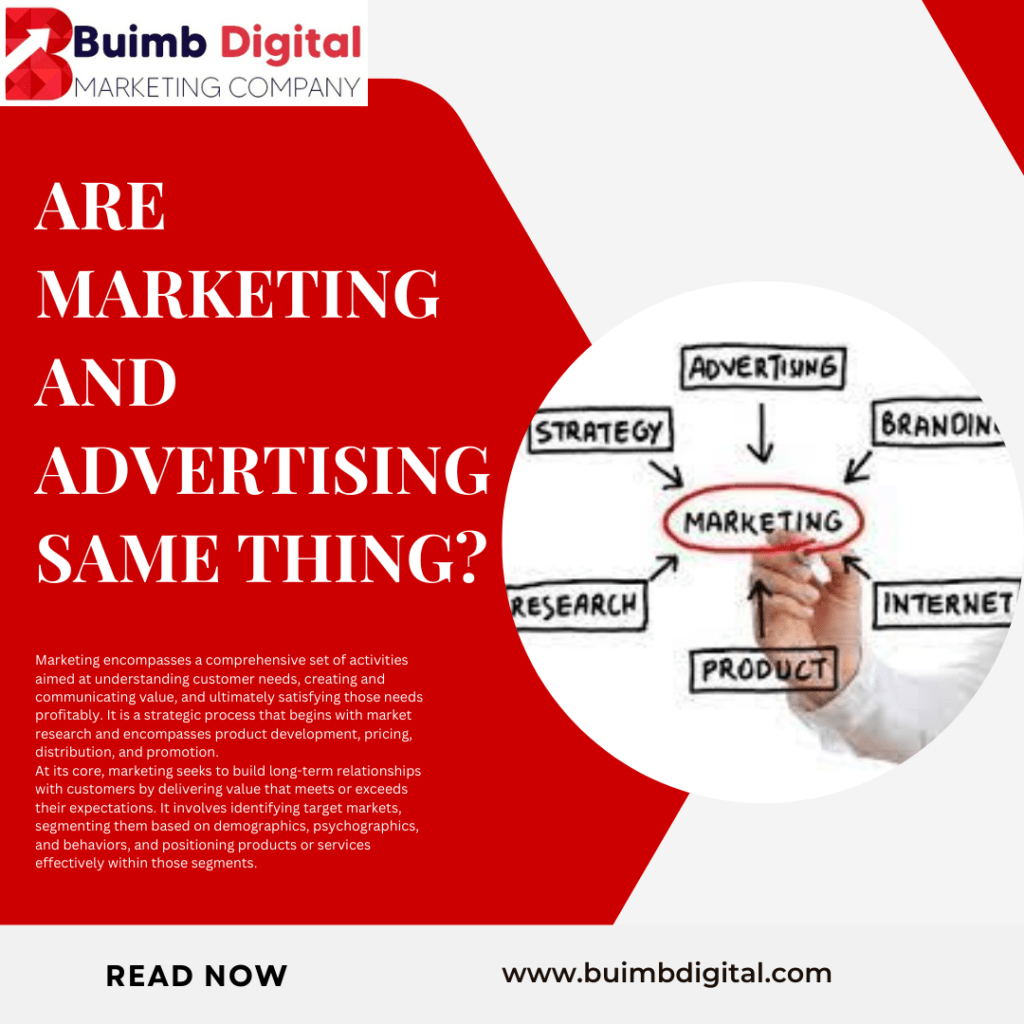Are Marketing and Advertising same thing?
Marketing encompasses a comprehensive set of activities aimed at understanding customer needs, creating and communicating value, and ultimately satisfying those needs profitably. It is a strategic process that begins with market research and encompasses product development, pricing, distribution, and promotion.At its core, marketing seeks to build long-term relationships with customers by delivering value that meets or exceeds their expectations. It involves identifying target markets, segmenting them based on demographics, psychographics, and behaviors, and positioning products or services effectively within those segments.

Components of Marketing
- Market Research: Gathering and analyzing data about consumer preferences, behaviors, and trends to identify opportunities and inform decision-making.
- Product Development: Creating offerings that address specific customer needs or desires, often incorporating insights gained from market research.
- Pricing Strategy: Determining the optimal price point based on factors such as market demand, competition, and perceived value.
- Distribution Channels: Developing strategies for delivering products or services to consumers through various channels, ensuring accessibility and convenience.
- Promotion: Communicating the value of products or services to the target audience through advertising, public relations, sales promotions, and other promotional tactics.
Understanding Advertising
Advertising is a subset of marketing and refers specifically to the paid, non-personal communication of messages by identified sponsors through various media. Its primary objective is to persuade target audiences to take action, such as purchasing a product, using a service, or supporting a cause.
Advertising campaigns are carefully crafted to create awareness, generate interest, and influence consumer perceptions. They often leverage creative concepts, visuals, and compelling messaging to capture attention and differentiate brands from competitors. Advertising can take many forms, including television commercials, print ads, online banners, social media sponsored posts, and more recently, influencer partnerships.
Key Characteristics of Advertising
- Paid Communication: Advertisers pay for placement of their messages in media channels, whether traditional (TV, radio, print) or digital (online, social media).
- Non-Personal: Unlike personal selling or direct marketing, advertising typically targets a mass audience rather than individual consumers.
- Controlled Messaging: Advertisers have control over the content, timing, and placement of their ads, allowing for strategic targeting and frequency management.
- Creative Execution: Effective advertising often relies on creativity and storytelling to engage audiences emotionally and intellectually, driving brand recall and consumer action.
Differentiating Marketing and Advertising
While marketing and advertising overlap in their objectives of promoting products or services, they differ significantly in scope, approach, and function within a company’s overall strategy.
- Scope: Marketing encompasses a broader range of activities beyond advertising, including market research, product development, pricing, and distribution strategies. Advertising is specifically focused on communicating promotional messages through paid channels.
- Objectives: Marketing aims to create value for customers and build long-term relationships, whereas advertising’s primary goal is immediate persuasion and response from target audiences.
- Audience Engagement: Marketing involves ongoing interactions and engagement with customers across various touchpoints, whereas advertising tends to be more one-way and focused on delivering a specific message at a particular moment.
- Timing and Duration: Marketing strategies are typically long-term and integrated across the entire customer journey, whereas advertising campaigns may be short-term and focused on achieving immediate results, such as boosting sales during a specific promotion.
The Role of Integrated Marketing Communications (IMC)
In practice, successful companies integrate various promotional elements, including advertising, into a cohesive marketing communications strategy known as Integrated Marketing Communications (IMC). IMC ensures consistency in messaging and maximizes the impact of promotional efforts by leveraging the strengths of each communication channel.
IMC encompasses not only advertising but also public relations (PR), direct marketing, sales promotions, personal selling, and digital marketing initiatives. By coordinating these activities, companies can create a unified brand image, enhance brand equity, and achieve synergy in their promotional efforts.
Examples of Integrated Marketing Campaigns
- Coca-Cola’s “Share a Coke” Campaign: This campaign involved personalized Coca-Cola bottles with people’s names printed on them, encouraging customers to find and share bottles with their friends and family. It integrated advertising (TV commercials, print ads), social media engagement (hashtags, user-generated content), and experiential marketing (pop-up events) to create a buzz and increase sales.
- Nike’s “Just Do It” Campaign: Nike’s iconic slogan has been central to its advertising strategy for decades. The campaign integrates powerful storytelling (celebrity endorsements, inspirational narratives), digital marketing (social media, online ads), and sponsorships (sports events, athletes) to reinforce its brand image of empowerment and performance.
Evolving Trends in Marketing and Advertising
The digital age has transformed both marketing and advertising landscapes, introducing new opportunities and challenges for businesses. Digital marketing channels, such as social media, search engine marketing (SEM), and content marketing, offer unprecedented targeting capabilities and real-time analytics, enabling marketers to reach specific audiences with precision and measure campaign effectiveness.
Furthermore, consumer behavior has shifted towards seeking personalized experiences and authentic interactions with brands. This trend has led to the rise of influencer marketing, where brands collaborate with social media personalities and content creators to reach niche audiences and build credibility through trusted endorsements.
Conclusion: Bridging the Gap
In conclusion, while marketing and advertising are closely related, they are distinct disciplines with unique roles and objectives within the broader framework of business promotion. Marketing encompasses the entire process of understanding customer needs, creating value, and delivering offerings to the market, while advertising focuses specifically on communicating promotional messages through paid channels.
Successful businesses recognize the importance of integrating various promotional elements into a cohesive marketing strategy that aligns with their overall business objectives and brand identity. By leveraging the strengths of both marketing and advertising and embracing digital innovation and consumer-centric approaches, companies can effectively engage audiences, build brand loyalty, and drive sustainable growth in today’s competitive marketplace.



